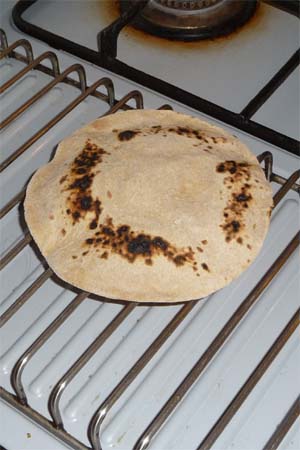
Simple, healthy and delicious. Don’t let the long list of instructions alarm you! Once you get used to the process, you can throw together delicious chapattis in minutes with no measuring and no stress.

| 2 | cups | atta flour* |
| 1 | teaspoon | salt |
| ~ | water |
* Atta” is the Hindi word for high protein durum wheat, similar to that used in pasta. You'll find it at Indian grocery stores or online.
Making chapatti dough:
- Combine two cups of atta flour with one teaspoon of salt in a spacious bowl. Mix well.
- Pour a small amount of water over the flour and stir to begin forming dough. Sprinkle water over the mixture as needed to create a “kneadable” consistency.
- Turn the dough out on a lightly floured surface and knead until smooth—several minutes.
- Cover with a towel and let the dough rest for 20–30 minutes.
Note: Do not skip this step or the dough will be tough and produce inferior chapattis.
Rolling your chapatti:
- Pull off a small piece of dough approximately 1 ¾ inches in diameter—the size of a golf ball.
- Roll the dough ball between your hands until smooth.
- Flatten the dough slightly and dip in atta flour to prevent sticking as you work.
- Place the dough on a clean, lightly floured working surface.
- Lightly flour your rolling pin and roll it briskly back and forth across the dough in a continuous motion, turning it as you work to form a round disk about 1/6-inch thick.
Note: Keep your fingers straight and loose on the rolling pin, and let your fingertips do all the work. And know that perfectly circular, thin chapattis take lots of practice. Once you have the technique down, you can make them in your sleep—or not.
Cooking your chapatti:
- Heat a heavy-bottomed skillet, griddle or Indian tava (a slightly concave griddle used to make flatbreads) over medium heat.
- Place the chapatti in the center and cook until slightly darkened in color with raised bumps—approximately one minute.
- Flip the chapatti and cook for another minute.Note: Do not overcook the chapatti; you want it to be soft and tender at this stage.
- Press around the edges of the chapatti with a clean kitchen towel. This seals the edge and ensures that the bread will puff properly in the next stage of cooking.
- Place the chapatti on an open flame like a stovetop gas burner and watch it puff quickly like a balloon. Turn it over and keep it moving in a circular motion to prevent overcooking. It’s done when it begins showing brown blisters.
- Serve immediately.Note: For best flavor and texture, make chapatis fresh for each meal. If you do have leftovers, reheat them quickly over a medium flame, being careful not to burn. Older chapatis should be wrapped in a clean kitchen towel, microwaved on high for one minute, then placed over an open flame to perk them up.


